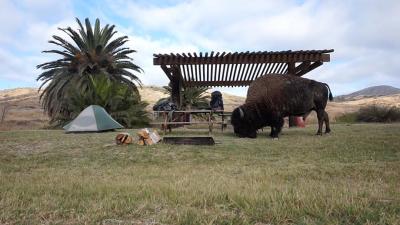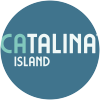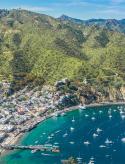Hiking on Catalina Island is one of the most popular things to do on the island, and one of the most popular trails is the challenging Trans-Catalina Trail. Here are 12 things you need to know to take on this rewarding hike.
1. The trail is longer than you must think: Even though the island is just 22 miles long, due to the island’s topography the Trans-Catalina Trail is 38.5 miles. The trail traverse the island from one side to the other.
2. It is not end to end: Despite its name, the Trans-Catalina Trail doesn’t go from one end of the island to the other. Avalon and Parsons Landing are the end points of the trail, both of which are a few miles from the east and west ends of the island respectively. The TCT is broken into sections: Avalon to Black Jack, Black Jack to Little Harbor, Little Harbor to Two Harbors, Two Harbors to Parsons Landing, Parsons Landing back to Two Harbors.
3. There are some great campgrounds along the way: Camping on Catalina Island has long been popular, and the Trans-Catalina Trail includes some of the island’s most scenic campgrounds. Camping is only permitted in five designated campgrounds along the Trans-Catalina Trail. Those campgrounds are Hermit Gulch, Blackjack, Little Harbor, Two Harbors Campground and Parsons Landing. Campers agree that Little Harbor and Parsons landing are the most scenic with their beach front locations.
Camping is only permitted in five designated campgrounds along the Trans-Catalina Trail. Those campgrounds are Hermit Gulch, Blackjack, Little Harbor, Two Harbors Campground and Parsons Landing. Campers agree that Little Harbor and Parsons landing are the most scenic with their beach front locations.
4. You will need reservations to camp: Speaking of those campgrounds, they can be popular, so make sure you make reservations in advance. Click here for camping reservations.Camping reservations for the year open on January 1.
5. You can’t do it all in a day, but you can enjoy it in a day: Depending on how fast you like to hike, it will take on average three days to hike the Trans-Catalina Trail, but you don’t need to do those days consecutively. Many people choose to enjoy hikes on the TCT on several visits to Catalina Island, rather than just completing it as a thru-hike.
Taking on the Trans Catalina Trail this way allows you to enjoy some of the many other activities available on Catalina Island, including kayaking, snorkeling, golf, shopping and sightseeing.
6. It’s challenging: While it is spectacular, the Trans-Catalina Trail is not for those looking for a relaxing stroll. Catalina Island’s terrain is rugged and the Trans-Catalina Trail includes dramatic elevation changes and some steep drop-offs. All that effort is worth the payoff of awe-inspiring views of the Pacific Ocean.
7. You can get help with your gear. If the thought of carrying all your gear on what for most people is a strenuous hike seems a little too daunting, gear hauls are available that let you hike the trail with just a day pack. Contact Catalina Backcountry for more information. Catalina Backcountry can also set up camp and meals for hikers along the trail.
8. Carry a map and your phone: That map will help you know where you are and where you need to go. Cell phone service is available just about everywhere on the island (Verizon users will have the most service), if you get it trouble, use your phone to call 911. Rangers are available at Hermit Gulch in Avalon, Little Harbor (4.5 miles from Two Harbors) and Two Harbor Campgrounds.
9. Keep an eye out for the wildlife: North American Bison were introduced to the island in 1924 and are frequently sighted while hiking on Catalina Island. Although they may seem placid from a distance, appearances can be deceiving. These large mammals can be short-tempered and unpredictable, and it is best not to approach them. The Catalina Island Conservancy advises staying at least 100 ft away from any bison, noting there is no guaranteed safe distance. Read more about Bison Safety. Like the rest of Southern California, Catalina Island is also home to rattlesnakes. Negative interactions with these reptiles are very rare, but rattlesnake venom is extremely toxic.
distance, appearances can be deceiving. These large mammals can be short-tempered and unpredictable, and it is best not to approach them. The Catalina Island Conservancy advises staying at least 100 ft away from any bison, noting there is no guaranteed safe distance. Read more about Bison Safety. Like the rest of Southern California, Catalina Island is also home to rattlesnakes. Negative interactions with these reptiles are very rare, but rattlesnake venom is extremely toxic.
10. Plan to hike when it’s cooler: One of the most common questions about hiking the Trans-Catalina Trail is “when is the best time to do it.” Hiking in the summer heat can be a challenge, so it’s best to try and avoid July and August. Fall and winter bring cooler temperatures and, particularly when there has been a good rainy season, spring brings an eruption of wildflowers and green hillsides.
11. Plan to bring water: No matter when – or where – you will be hiking on Catalina Island, you should plan to bring water. Although drinking water is available at campgrounds and a few other locations in the interior of the island, you will want to have water with you. Water can be purchased in Avalon and Two Harbors and at Airport in the Sky.
12. You need a permit: Whether you are hiking the Trans Catalina Trail or enjoying some of the island’s many other trails, you will need a free hiking permit from the Catalina Island Conservancy. Permits can be obtained online or on the island at the Trailhead Center in Avalon, the Airport in the Sky, the Nature Center, the Wrigley Memorial & Botanic Garden or Two Harbors Visitor Services. If you are camping along the Trans-Catalina Trail, hiking permits are including in the your camping reservations.
Tips:
- Leave your propane at home. It's not allowed on the Catalina Express and can be purchased in Avalon or Two Harbors.
- Having trouble getting a reservation for the campsite that you want on the day you planned? Call Two Harbors Visitor Services for assistance. 310-510-4208
- Don't miss a stop at Airport in the Sky Restaurant. Bison Burgers, Breakfast Burritos and Killer Cookies are among the favorites.
- Join an online Facebook group to get trail tips and tricks from other hikers and campers.
Visit our Catalina Island Hiking page for Trans-Catalina Trail routes and mileage.



